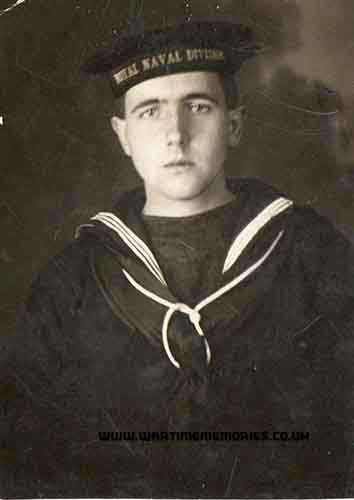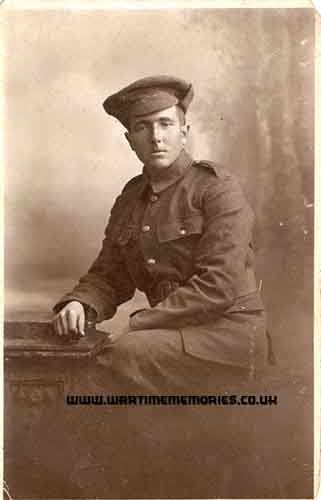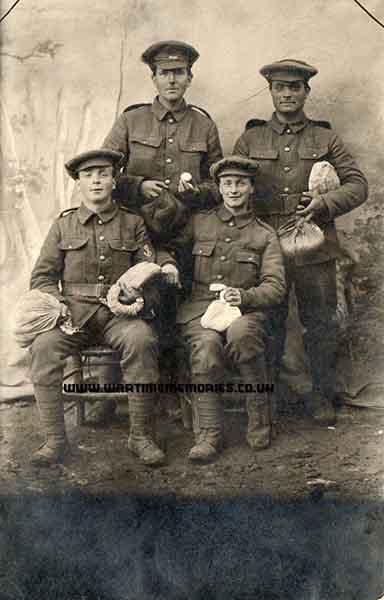Additions will be checked before being published on the website and where possible will be forwarded to the person who submitted the original entries. Your contact details will not be forwarded, but they can send a reply via this messaging system.
please scroll down to send a message
Able Sea. Edward Lunt
Royal Naval Divison Howe Bn
from:Fazakerley, Liverpool
(d.26th Oct 1917)
Ted Lunt was born on 7th August, 1893, at Brookfield Farm in Fazakerley, which was in those days just on the outskirts of Liverpool. He was the youngest of seven surviving children and while his two older brothers became farmers and his four sisters all teachers, Ted was apprenticed at Harmood-Banner & Co Accountants in Liverpool itself.
Not long after the outbreak of war, on 26th September, 1914, Ted enlisted in the Royal Naval Division and after his basic training at Crystal Palace he was drafted to 'C' Company, Howe Battalion. Now an Able Seaman, he went with the battalion to the Mediterranean and took part in a minor action at Kantara on the Suez Canal before landing at Gallipoli on 29th April, 1915. Not long afterwards, on 9th May, in the aftermath of the 2nd Battle of Krithia, Ted was shot in the shoulder and on 14th May he was evacuated from the peninsular. He got as far as Malta before evidently recovering sufficiently to be sent back, returning via Alexandria to rejoin Howe Battalion on 28th June. Many of his comrades had, in the meantime, been killed in the 3rd Battle of Krithia, in which the RND suffered heavy casualties.
On 8th September, 1915, Ted wrote to his sister Agnes: "Here we are again, fed up with the monotony of existence & especially that of the grub. We sometimes get boiled rice instead of half our ration of jam & we sometimes get raisins and a few figs. Somebody mentioned flies, well it’s getting a little colder now so they are not so troublesome, but previously in the trenches if you stopped wagging your right hand for a moment the bread and jam in your left became covered with flies & while taking your hand to your mouth one or two of the blighters would get on the jam. I will leave out one or two gruesome details or I might turn you against jam for ever. ... Last time up in the trenches we held a kind of sap which was really an old communication trench leading into the Turks trench, our barricade was only forty yards off their trench, we were in it for four days. We only lost one man wounded by a piece of shell one night when a bombardment was on. One night the officer and I pulled down some sandbags, rolled over the parapet & starting at our barricade put coils of trench wire ten yards from the trench & down one side of it up to our main trench. One of the privileges of being leading seaman, the sooner Henderson comes back to his job the better. I was pleased, I don’t think, because last time but one I was in charge of four chaps putting barbed wire up for four hours between the support trench and the firing line. Luckily the ground that time was nearly all sheltered by the high parapet of the fire trench. Of course I don’t want mother to know I go in the trenches at all, you can tell her we are still busy digging trenches, which is true, because our chaps dig saps & trenches every time we go to the trenches..."
Presumably, Henderson did not come back to his job, as Ted was confirmed as Leading Seaman on 28th September. Like many thousands of men at Gallipoli, he later suffered from disease (Hepatitis A, in his case, from contaminated food or water)- he had only just been discharged from hospital in January 1916 when the peninsular was evacuated. The RND was eventually sent to France, arriving in Marseilles in May 1916- but Ted had been sent home on extended leave in February and didn't rejoin his battalion until 6th June. Evidently, recuperation was protracted- indeed, the photo of him in khaki seems to show signs of jaundice in his face.
Howe Battalion were sent to the Angres-Souchez sector, near Lens. On 9th September, 1916, Ted wrote: "The lighter Will sent is tres bon and I want another as I left it alight in my pocket and used up half of it. Also send some sulphur ointment as some of my friends are very scabby and have been using it for me. Its a lovely day, I am lying on the grass with a lovely valley stretched in front of me with woods and villages scattered along it. The villages near at hand look a little careworn, sometimes a family lives in a house with the house next door minus a gable end or with half its roof off. In one village live two old ladies of about seventy years of age, they keep an estaminet and sell weak beer to some of the boys, now and again the estaminet runs dry for a day or two. The place is surrounded by ruins and opposite the door stands the remains of the village church. Gee Whiz if the French and Belgians ever get into Germany there will be something doing, I don’t think their officers could control them, and I am sure British troops would sympathise with them. Dilapidated scenes are part of the landscape with us, but with the French they must signify more."
On 13th November, 1916, the RND (now the 63rd Division) made an assault on the village of Beaucourt-sur-l'Ancre, in what would prove to be the last phase of the Somme campaign. After vicious fighting, they captured the village- Ted, however, was again wounded, once more in the shoulder or upper arm. He was invalided to England and recuperated in the General Hospital in Manchester. Again, he recovered and was sent to the RND base at Blandford Camp in Dorset, where on 16th February, 1917, he reverted to Able Seaman at his own request- the reasons for this are unknown. On 14th March he was drafted to France, rejoining Howe Battalion on 28th April, in the aftermath of more heavy fighting at Gavrelle.
On 26th October, 1917, the RND took part in the opening of the Second Battle of Passchendaele, their role being to make an attack on positions immediately to the northwest of Passcahendaele Ridge, in support of the Canadian Corps on the ridge itself. Being on low-lying ground below the ridge, with the flooded stream of the Paddebeek running across their front, conditions were truly appalling, swamp-like and in places simply impassible. Howe Battalion began in support, but were soon called upon to move through the Anson Battalion around Varlet Farm and press forward to try to cross the Paddebeek. Elements of C Company, including Ted, got through the German positions at bayonet point and succeeded in crossing the stream- at about 9am, a Canadian officer on the ridge spotted a party of about 15 men and one officer on the other side of the water. The Germans then counter-attacked and this little group were forced sideways into the Canadian sector, where some of them eventually found their way back to safety through Canadian lines. Ted, however, was not so lucky. He was shot dead and initially buried by or inside a pillbox. Today, he lies in Poelkapelle Cemetery, to the north-east of Ypres. He was my great-uncle.


